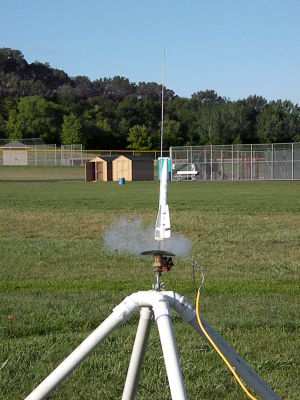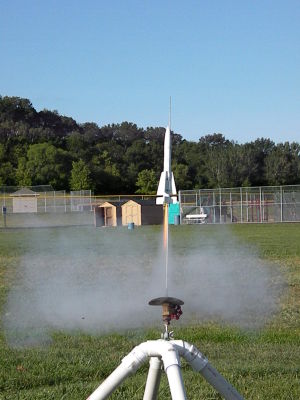Scratch Baby Phoenix Original Design / Scratch Built
Scratch - Baby Phoenix {Scratch}
Contributed by Ray King
| Manufacturer: | Scratch |

Brief:
This is my submission for the 2008 EMRR Challenge #6 - Downscale "Real" Rocket. I have all ways liked the
look of the AIM-54A Phoenix guided missile. I decided I would start with the Estes Phoenix kit as a guide along with
the scale data and pictures I could find on the internet. This is roughly a 63% reduction from the Estes kit with a few
modifications based on the other data. This "baby" Phoenix is a high flier set up for 24mm motors.
Construction:
Parts list:
- 1 4" BT-50 Balsa Nose Cone
- 1 8.1875" BT-50 Tube
- 2 0.625" X 0.125 launch lugs
- 1 18" 400# Kevlar® Shock Cord
- 2 12" 180# Kevlar® Shock Cord
- 1 BT-50 Motor Centering Ring
- 1 3/32" Balsa Sheet
- 1oz Nose Weight (BBs)
- 1 Clear Decal Sheet
After doing all the scale calculations, the assembly was pretty basic.
Main Body Tube Assembly: Start with a BT-50 tube (cut to length), 1 piece of the 180# Kevlar® and motor centering ring. Tie one end of the Kevlar® to centering ring and using an old 24mm engine, glue the centering ring in place setting the motor location. Next, pull the Kevlar® through the other end of the tube. This will be attached the parachute and nose cone.
Fins Construction: Next, using the templates attached cut out the fins and sand the edges accordingly. Mark the locations for the fins 90 degrees apart and launch lug between one set of fins. Then, mount the bottom most fins and then mount the top fins 0.350" above the top of the bottom fins. Next, add generous epoxy fillets to all the fins. This may deviate from the real rocket, but in my opinion is required to avoid breaking on landing.
Nose Cone: I started with a balsa nose cone and sanded it the look more like the phoenix nose cone.
After running a number of scenarios, I settled on adding an ounce of nose weight. This would allow me to fly a D engine if the field is big enough. Next, drill out the nose cone for clearance for the nose weight. Now, tie the other 180# Kevlar® cord into a loop and epoxy to the bottom of hole you just drilled for the nose weight. When the epoxy has setup, glue the nose weight into the nose cone.
Finally, attach the 2 Kevlar® pieces (one from the nose cone and the other from the body tube) using the 24 inch 400# Kevlar® cord. Attach the parachute to the 400# Kevlar® cord--make sure the nose cone and body tube do not make contact with one another.

Finishing:
As with most of the rockets I build, the building time is pretty quick and the finishing is what takes the time and
patience. I filled the fins with thinned Elmer's Wood Filler and sanded, repeating this a couple times until the fins
were smooth. I primed it and painted it with gloss white. Once the white was dry, I painted the silver ring at the base
of the nose cone.
I scanned the decals from the Estes kit. I reduced them accordingly and printed onto "Expert-Choice" clear waterslide decal material. After applying the decals, I applied 3 coats of clear coat.
Flight and Recovery:
Flight prep was pretty standard with one exception: I used a foam plug instead of wadding or "dog barf". I
used an 18" parachute and the big debate was what engine to use, C11 or D12? It was a little breezy (10 mph) and I
was worried about recovery. The launch field was surrounded by trees and neighborhoods. I choose to go conservative and
use a C11-5.
With the rod angled into the wind, the rocket left faster than I expected and as predicted it flew very high. The parachute ejected and opened nicely, and the wind took it from there. The rocket landed a very long away just to the left of a dense forest. I opted to only make one flight today but am looking forward making more when it is not so windy.


Summary:
This is a great little rocket and I can't wait to finish its older brother and fly them together.
Sponsored Ads
 |
 |











